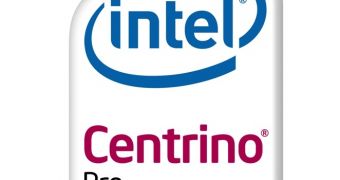Yesterday, Intel was celebrating 30 years in the embedded computing domain, now they're wiping the dust off their shoes and going ahead with a new daunting task: to take the notebook market by the horns. This is the long awaited moment that Intel has been preparing its "audience" for for some time now, the Intel Centrino Pro processor technology is here, bow your heads down in respect.
Mooly Eden, vice president of Intel Mobile Products Group said: "Intel Centrino Pro processor technology brings the best of our offering with Intel vPro processor technology and adds it right into our highly successful Intel Centrino brand for laptops. This is an ideal time for this product as we continue to see notebook penetration rates increasing in business."
The fourth generation of mobile platforms that Intel will bring upon us, mere mortals, uses the second generation Intel Core 2 processor, codenamed Merom, has an 800 MHz Front Side Bus with Dynamic FSB Switching, Intel's Mobile 965 Express chipset with Intel GMA X3000, a NAND flash memory for caching called Robson a.k.a. Turbo Memory. It's also expected of having EFI, a successor of the BIOS and Intel Dynamic Acceleration Technology. One other feature is Intel's vPro technology which allows for a more secure way of managing and troubleshooting computers and notebooks alike, and do this even through a wireless connection.
Intel Centrino Pro will be available in the second quarter of 2007, as a part of Santa Rosa. This platform also includes an Intel Next-Gen Wireless-N wireless components compatible with the IEEE 802.11n draft, while for Robson, it's predicted that it will bring up to two times faster performance "when loading frequently-used applications" and "a 20% faster boot time". Now don't expect to see any knights in shining armor to come and make your notebook fly on its own, that's not going to happen unless you throw it out the window (not recommended), but some improvements are going to be seen, much like the optimizations seen in Windows Vista through their Ready Boost initiative.

 14 DAY TRIAL //
14 DAY TRIAL //